Related Research Articles
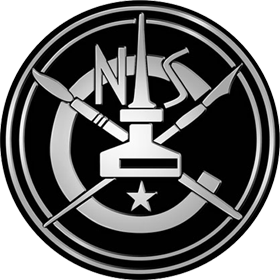
The National Cartoonists Society (NCS) is an organization of professional cartoonists in the United States. It presents the National Cartoonists Society Awards. The Society was born in 1946 when groups of cartoonists got together to entertain the troops. They enjoyed each other's company and decided to meet on a regular basis.
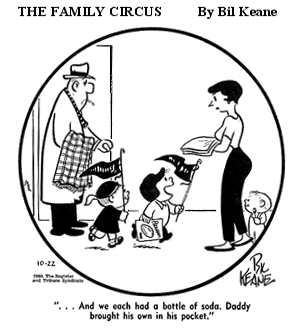
The Family Circus is a syndicated comic strip created by cartoonist Bil Keane and, since Bil's death in 2011, is currently written, inked, and rendered (colored) by his son, Jeff Keane. The strip generally uses a single captioned panel with a round border, hence the original name of the series, which was changed following objections from the magazine Family Circle. The series debuted on February 29, 1960, and has been in continuous production ever since. According to publisher King Features Syndicate, it is the most widely syndicated cartoon panel in the world, appearing in 1,500 newspapers. Compilations of Family Circus comic strips have sold over 13 million copies worldwide.
The Dysfunctional Family Circus was the name of several long-running parodies of the syndicated comic strip The Family Circus, featuring either Bil Keane's artwork with altered captions, or original artwork made to appear like the targeted strips. First distributed anonymously by mail and fax in 1989, by 1994 various versions of it began to appear on the World Wide Web. The most popular version, edited by Greg Galcik, began in 1995 and ceased in 1999 following a telephone conversation between Galcik and Keane.

William Aloysius "Bil" Keane was an American cartoonist most notable for his work on the newspaper comic The Family Circus. It began in 1960 and continues in syndication, drawn by his son Jeff Keane.
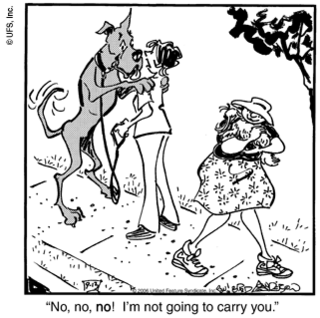
Marmaduke is a newspaper comic strip revolving around the Winslow family and their Great Dane, Marmaduke, drawn by Brad Anderson from June 1954 to 2015.
The comic strip switcheroo was a massive practical joke in which several comic strip writers and artists (cartoonists), without the foreknowledge of their editors, traded strips for a day on April Fools' Day 1997. The Switcheroo was masterminded by comic strip creators Rick Kirkman and Jerry Scott, creators of the Baby Blues daily newspaper comic strip.
Lawncrest is a neighborhood in the "Near" (lower) Northeast Philadelphia, Pennsylvania. The name is an amalgam of Lawndale and Crescentville, the two primary communities that make up the neighborhood. The Philadelphia Inquirer does not consider Lawncrest to be a neighborhood.
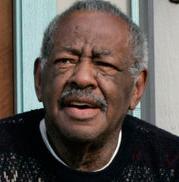
Morris Nolton Turner was an American cartoonist, creator of the strip Wee Pals, the first American syndicated strip with an integrated cast of characters.
Channel Chuckles is a television-themed comic panel created by Bil Keane which appeared in newspapers from 1954 through 1976. Keane received the National Cartoonists Society's 1976 Special Features Award for his work on the strip.
Gerald "Jerry" Buckley was an American cartoonist who had also worked as an art director and a college professor.
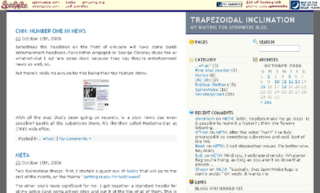
SpinnWebe was the personal website of Greg Galcik, also known as "spinn." It gathered the most fame as the home of the Dysfunctional Family Circus, which ran in the late 1990s. Additionally, the site was the showcase for a number of Galcik's other projects, which generally had interactive humor as the unifying theme; in this respect, it anticipated the development of later sites such as Fark and Something Awful. The name SpinnWebe comes from an infamously bad machine translation of the German word for "spider web."
Robb Armstrong is an African American cartoonist, best known for creating the comic strip Jump Start. His comic strip Jump Start is the most widely syndicated daily strip by an African American in the world.
Jeff Keane is an American cartoonist. He is the youngest son of the late cartoonist Bil Keane who, following his father's death in 2011, became inker and colorist of the syndicated comic strip The Family Circus, after having assisted on it since 1981.

Our Boarding House is an American single-panel cartoon and comic strip created by Gene Ahern on October 3, 1921 and syndicated by Newspaper Enterprise Association. Set in a boarding house run by the sensible Mrs. Hoople, it drew humor from the interactions of her grandiose, tall-tale-telling husband, the self-styled Major Hoople, with the rooming-house denizens and his various friends and cronies.
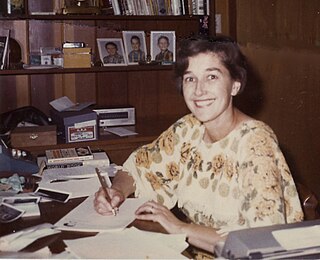
Thelma "Thel" Keane was the Australian-born American wife of The Family Circus newspaper cartoonist, Bil Keane. Keane served as her husband's inspiration and model for the "Mommy" character in his long-running comic strip and was instrumental in restoring the copyrights for The Family Circus to her husband.

The Billy Ireland Cartoon Library & Museum is a research library of American cartoons and comic art affiliated with the Ohio State University library system in Columbus, Ohio. Formerly known as the Cartoon Research Library and the Cartoon Library & Museum, it holds the world's largest and most comprehensive academic research facility documenting and displaying original and printed comic strips, editorial cartoons, and cartoon art. The museum is named after the Ohio cartoonist Billy Ireland.
Cartoonists Remember 9/11 is a series of comic strips run on the tenth anniversary of the September 11, 2001 attacks on the United States. It included cartoonists from King Features Syndicate, Creators Syndicate, Tribune Media Services, Universal Press Syndicate, and Washington Post Writers Group.
The Register and Tribune Syndicate was a syndication service based in Des Moines, Iowa, that operated from 1922 to 1986, when it was acquired by King Features to become the Cowles Syndicate affiliate. At its peak, the Register and Tribune Syndicate offered newspapers some 60 to 75 features, including editorial cartoonist Herblock, comic strips, and commentaries by David Horowitz, Stanley Karnow, and others.
Silly Symphony, initially titled Silly Symphonies, is a weekly Disney comic strip that debuted on January 10, 1932 as a topper for the Mickey Mouse strip's Sunday page. The strip featured adaptations of Walt Disney's popular short film series, Silly Symphony, which released 75 cartoons from 1929 to 1939, as well as other cartoons and animated films. The comic strip outlived its parent series by six years, ending on October 7, 1945.
William Raphael Louis Dwyer, Jr., known as Bil Dwyer, was an American cartoonist and humorist. He was known for several newspaper comic strips in the 1930s and 1950s, including Dumb Dora and Sandy Hill, as well as a series of humorous books of Southern slang published in the 1970s.
References
- 1 2 Holtz, Allan (2012). American Newspaper Comics: An Encyclopedic Reference Guide. Ann Arbor: The University of Michigan Press. p. 351. ISBN 9780472117567.
- 1 2 Bil Keane Cartoons 1954-1966 Syracuse University, 21 Jul 2009, Retrieved 11/30/2010